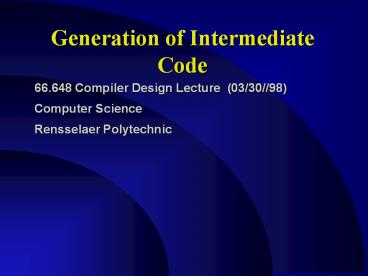Generation of Intermediate Code PowerPoint PPT Presentation
Title: Generation of Intermediate Code
1
Generation of Intermediate Code
- 66.648 Compiler Design Lecture (03/30//98)
- Computer Science
- Rensselaer Polytechnic
2
Lecture Outline
- Intermediate Codes for if
- Backpatching
- Examples
- Administration
3
Short-circuit code approach
- Idea use conditional jump instruction after
evaluating partial expression. - Example
- a and b and c
- if a were false, then we need not evaluate the
rest of the expressions. So, we insert labels
E.true and E.false in the appropriate places.
4
Short Circuit - Contd
- If a goto E.true
- goto E.false
- E.true if b goto E1.true
- goto E.false
- E1.true if c goto E2.true
- goto E.false
- E2.true exp 1
- E.false exp 0
5
Syntax Directed Translation
- The translation uses the following attributes
true, false, and code. True and false are
inherited attributes whereas code is a
synthesized attribute. The inherited attribute
true and false specify the true and false branch
destinations for the short circuit code generated
by sub-expressions. - Caution The true and false inherited attributes
cannot be evaluated on the fly using bottom-up
parsing. One needs to build a parse tree and the
dependency graph for evaluating the attributes.
6
Syntax-Directed Translation
- E1 --gt E2 or T E2.true E1.true
T.trueE1.true E2.falsenewlabel()
T.falseE1.false E1.code gen(labelE2.false,
) T.code - E1--gt T T.trueE1.trueT.falseE.falseE.codeT.
code - T1--gt T2 and F T2.truenewlabel()F.trueT1.true
T2.falseT1.falseF.falseT1.falseT1.codeT2.co
degen(label,T2.true,.)F.code - T--gtF F.trueT.trueF.falseT.falseT.codeF.cod
e
7
Syntax-Directed Translation
- F--gt NOT F1 F1.falseF.trueF1.trueF.false
F.codeF1.code - F--gt (E) E.trueF.trueE.falseF.false
F.codeE.code - F--gt ID1 RELOP ID2 F.codegen(ifID1.place
RELOP ID2.place goto F.true gen(goto
F.false - F--gt True F.codegen(gotoF.true)
- F--gt false F.codegen(gotoF.false)
8
Generating Code for Switch Stmts
- Switch/Case statement in source language form
- switch(expr)
- case_value1 Stmt1
- ..
- Case_valuen-1Stmt(n-1)
- default Stmtn
9
Translation into 3 A C
- Translation of source switch/case statement into
intermediate language 3 A C. - Switchstmt.code
- code to evaluate expression into temporary t
- goto test
- L1 code for Stmt1
- goto next
- L2 code for Stmt2
10
Switch Stmt
- Goto next
- L(n-1) code for Stmt(n-1)
- go to next
- L(n) code for Stmt(n)
- goto next
- test if tV1 goto L1
- if (tV2) goto L2
- if (tV(n-1)) goto L(n-1) else goto L(n)
11
Switch Statement
- It becomes the responsibility of the code
generation phase to generate an efficient
implementation of a n-way branch. - Common ideas use a hash table, balance tree or a
combination of the above.
12
Back patching
- Back patching is a technique to solve the problem
of replacing symbolic names in goto statements by
the actual target addresses. - This problem comes up because of some languages
do not allow symbolic names in the branches. - Idea Maintain a list of branches that have the
same target label and replace them once they are
defined.
13
Example
- Source
- if a or b then
- if c then
- x y1
- Translation
- if a go to L1
- if b go to L1
- go to L3
14
Example-Contd
- L1 if c goto L2
- goto L3
- L2 x y1
- L3
- After Backpatching
- 100 if a goto 103
- 101 if b goto 103
- goto 106
15
Back patching
- List operations
- merge(p1,p2) - merges two lists pointed by p1 and
p2 - back patch(p,j) inserts the target label j for
each list pointed by p. - Attributes are addr (address of the marker
symbol), nextlist (list of jumps whose addresses
have to be filled by address that follows the
current stmt), truelist and falselist
16
Back patching- Syntax Directed Translation
- We assume that the function next_address()
returns the address to be occupied by the next
intermediate language statement that is
generated. - Stmts--gt stmt stmts.nextliststmt.nextlist
- stmts1--gtstmts2 marker stmt backpatch (
stmts2. extlist,marker.addr) stmts1.nextlist
stmt.nextlist - marker --gt epsilon marker.address
nextaddress()
17
Back patching- Syntax Directed Translation
- Stmt1 --gt IF expr THEN marker stmt2
backpatch(expr.truelist,marker.addr)
stmt1.nextlistmerge(stmt2.nextlist,expr.falselist
) - Stmt1 --gt While marker expr DO marker1 stmt2
backpatch(stmt2.nextlist,marker.addr)backpatch(ex
pr.truelist,marker1.addr) stmt1.nextlistexpr.fal
selist - stmt ID expr stmt.nextlistnil
18
Examples
- If a or b then
- if c then
- xy1
- 100 if a goto ____
- 101 if b goto ____
- 102 goto ____
- 103 if c goto ____
- 104 goto ____
19
3 AC Statements
20
Comments and Feedback
- Projects 3 and 4 are out. Please start working.
PLEASE do not wait for the due date to come. - We are in chapter 8. Please read that chapter and
read the relevant portion of Java. Please keep
studying this material and work exercises.

